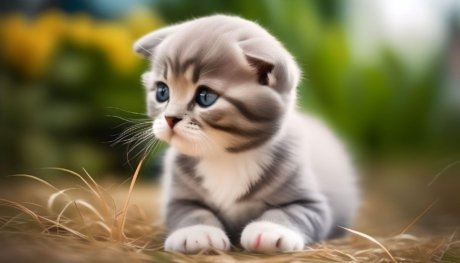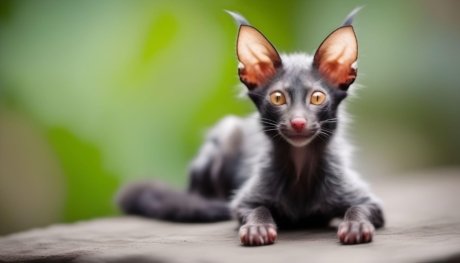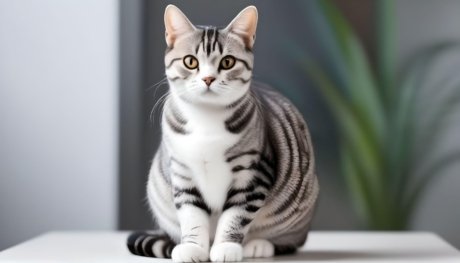Chimera Cats | Personality, Prices, Care Tips, 10 Facts, Food, Health Issues
In the enchanting realm of feline wonders, the Chimera Cat shines as a rare gem. Born of a genetic phenomenon, these cats exhibit a jaw-dropping fusion of dual DNA sets, creating a visually captivating canvas. Join us as we unravel the mysteries of Chimera Cats, exploring their genetics, unique appearances, and their extraordinary place in the world of domestic felines.
Chimera Cat
A chimera cat is not your run-of-the-mill feline companion. Rather, it is a product of a genetic marvel that unfolds during embryonic development. This phenomenon occurs when two separate embryos fuse together, resulting in a single individual with two distinct sets of DNA. The term “chimera” draws its inspiration from Greek mythology, where it represents a creature with the combined features of a lion, a goat, and a serpent.

The Allure of Their Appearance:
One cannot help but be entranced by the appearance of chimera cats. They often showcase an astonishingly unique fur coloration pattern, where one side of their face or body differs radically from the other. This dichotomy creates a visual spectacle, with one side adorned in, for example, ebony black fur, while the other glistens with pristine white. The demarcation is usually stark, leaving onlookers in awe of the sheer beauty of this natural artwork.
The Genetic Symphony:
Understanding the genetics underlying chimera cats is a complex yet riveting endeavor. These felines emerge from the fusion of two separately fertilized eggs in the embryonic stage, each carrying its own distinct genetic code. The merging of these eggs results in a mosaic of DNA, which can manifest in various traits on each side of the cat’s body. These traits encompass not only fur color but also eye color, making each chimera cat a living masterpiece of genetic diversity.
Delving into Personality and Behavior:
Chimera cats are as diverse in their personalities as they are in their appearances. While some cat owners may claim that their chimera companions exhibit a “split” personality to match their visual duality, there exists no concrete scientific evidence to support this notion. Nonetheless, one cannot deny that chimera cats are as unique in their behaviors as they are in their genetics. They can be playful, affectionate, and are known to forge deep bonds with their human companions.
A Rising Star in Popularity:
The rarity of chimera cats has catapulted them into the spotlight of social media and the wider pet-loving community. Owners proudly share captivating photos of their chimera felines, showcasing the splendid fusion of colors that adorn their bodies. This surge in visibility has kindled the interest of researchers and cat enthusiasts, sparking a growing fascination with these exceptional creatures.
Chimera Tortoiseshell Cat
A Chimera Tortoiseshell Cat is an extraordinary feline that exemplifies the mesmerizing fusion of two distinct sets of DNA. These captivating cats boast a unique appearance characterized by the renowned tortoiseshell pattern, which manifests as a harmonious blend of black, orange, and sometimes even cream-colored fur. This genetic marvel results from the merging of two embryos in the womb, creating a visually stunning mosaic of colors. Chimera Tortoiseshell Cats are cherished not only for their exceptional beauty but also for the intriguing complexity of their genetic makeup.
Venus Cat Chimera
The Venus Cat Chimera stands as an embodiment of genetic wonder and aesthetic fascination. This remarkable feline showcases the breathtaking outcome of two separate sets of DNA within one individual. What truly sets the Venus Cat Chimera apart is its dual-faced appearance, where one side of its visage exhibits one set of colors, and the other side boasts an entirely different palette. This extraordinary feature has propelled the Venus Cat Chimera to fame in the world of cats, leaving admirers in awe of its striking and enigmatic presence.
Calico Chimera Cat
Calico Chimera Cats are living testaments to the awe-inspiring diversity that genetics can bring to the feline world. These captivating creatures display a rich tapestry of colors, characterized by patches of white, orange, and black fur. This striking appearance is the result of two embryos merging in the early stages of development, creating a genetic mosaic that is truly breathtaking. Calico Chimera Cats have earned a special place in the hearts of cat enthusiasts, celebrated not only for their unique appearance but also for their representation of the complexity of life.
White Chimera Cat
The White Chimera Cat is a captivating and elegant feline that showcases the mesmerizing effects of genetic diversity. Born from the fusion of two separate sets of DNA during embryonic development, these cats predominantly exhibit white fur. However, what sets them apart is the contrasting colors on one side of their bodies. This visual juxtaposition, where one side is predominantly white and the other features a different hue, creates a remarkable and unforgettable appearance. White Chimera Cats serve as a testament to the wonders of nature and the beauty of genetic variation.
Black And White Chimera Cat
The Black and White Chimera Cat is a striking example of genetic complexity and visual allure. These remarkable felines are born from the fusion of two embryos, resulting in a distinct dual-colored appearance. The most prominent feature of these cats is the sharp division between their black and white fur, creating a visually stunning contrast. Their unique genetic makeup not only distinguishes them in the world of cats but also captivates both cat enthusiasts and scientists alike, offering a captivating glimpse into the marvels of genetic diversity.

Tabby Chimera Cats:
Tabby chimera cats showcase the intricate and captivating tabby pattern, which can include bold stripes, spots, or swirls in various colors. The fusion of two embryos’ genetic codes results in a mesmerizing tabby coat that stands out.
Ginger Chimera Cats:
Ginger chimera cats are characterized by their predominantly orange fur, often complemented by white or black patches on the other side. Their vibrant and fiery appearance adds a distinctive charm to their presence.
Siamese Chimera Cats:
Siamese chimera cats display the classic Siamese coloration, with dark points on their ears, face, paws, and tail. The blending of two embryos’ genetics can lead to a unique variation on this traditional Siamese look, further highlighting their genetic complexity.
Types of Chimera Cats
Chimera cats are among the most captivating and enigmatic wonders of the feline world. These extraordinary creatures are born with a genetic quirk that results in a unique, dual-colored appearance, often creating visually stunning patterns. As we delve into the diverse types of chimera cats, we unravel the intricate tapestry of genetic variation within these remarkable felines.
- Tortoiseshell Chimera Cats:
- Calico Chimera Cats:
- Black and White Chimera Cats:
- White Chimera Cats:
- Venus Cat Chimera:
- Tabby Chimera Cats:
- Ginger Chimera Cats:
- Siamese Chimera Cats:
History of Chimera Cat
The history of Chimera Cats is a fascinating journey into the realms of genetic anomalies and captivating appearances. These remarkable felines have been documented sporadically over the years, often capturing the attention of scientists and cat enthusiasts alike. While records of Chimera Cats date back decades, it’s only in recent years, with the advent of social media, that their visibility has surged. Today, they stand as a testament to the wonders of nature’s genetic diversity, leaving an indelible mark on the world of cat breeding and research.
Appearance of Chimera Cats
Chimera Cats boast an appearance that is nothing short of awe-inspiring. Their defining feature is a remarkable fusion of two sets of DNA, which creates a visual masterpiece. This genetic mosaic can manifest as strikingly different fur colors on each side of their bodies, including black and white, tortoiseshell, or calico patterns. Their captivating appearances have earned them a special place in the hearts of cat lovers worldwide, making them a sought-after and cherished addition to the world of domestic cats.

Temperament of Chimera Cat
The temperament of a Chimera Cat is as unique as its appearance. While there is no scientific evidence to support claims of a “split” personality, these felines are known for their diverse behaviors and individual quirks. Some may be playful and affectionate, while others display a more reserved demeanor. Much like any other cat, their temperament largely depends on their upbringing and socialization. What remains consistent, however, is their ability to forge strong bonds with their human companions, making them wonderful and cherished pets.
Behaviour of Chimera Cat
The behavior of Chimera Cats is a captivating subject of study for feline enthusiasts and scientists alike. These extraordinary felines exhibit a wide range of behaviors, just like any other domestic cat. They can be playful, independent, or affectionate, depending on their individual personalities and upbringing. What sets them apart is their exceptional genetic makeup, which adds an element of intrigue to their behaviors. Understanding their behavior adds another layer of fascination to these remarkable creatures, making them subjects of ongoing research and admiration.
How Rare Are Chimera Cats
Chimera Cats are exceptionally rare in the feline world. The occurrence of these genetic anomalies is a matter of chance, and their rarity is evident from their infrequent appearances. While it’s challenging to estimate precise numbers, they are considered a rare gem in the world of cats. Their scarcity only adds to their allure, making them highly sought after and treasured by those fortunate enough to share their lives with these exceptional felines.
Chimera Cat Price
The price of a Chimera Cat in the USA typically ranges from $1,000 to $3,000, while in India, due to their rarity, prices can vary widely, with averages spanning from INR 20,000 to INR 1,00,000 or more, contingent on factors like lineage and unique appearances.
Chimera Cat Price in the United States:
The price of a Chimera Cat in the United States can vary significantly depending on factors such as the cat’s lineage, appearance, and breeder reputation. In United States, On average, you can expect to pay anywhere from $1,000 to $3,000 for a Chimera Cat from a reputable breeder. Exceptional and rare specimens with striking appearances may command higher prices. It’s essential to do thorough research and choose a responsible breeder who prioritizes the health and well-being of the cats.
Chimera Cat Price in the United Kingdom:
In the United Kingdom, the price of a Chimera Cat can also vary based on similar factors. In United Kingdom, Typically, you may find Chimera Cats priced between £800 to £2,500, or even more for exceptional examples. It’s crucial to work with reputable breeders who adhere to ethical breeding practices and prioritize the welfare of the cats. Ensure that you receive proper documentation and health records when purchasing a Chimera Cat in the UK.
Chimera Cat Price in Australia:
Chimera Cats are relatively rare in Australia, and as such, their prices tend to be higher compared to more common cat breeds. In Australia, you might expect to pay anywhere from AUD 1,500 to AUD 5,000 or more for a Chimera Cat, depending on its genetic uniqueness and the breeder’s reputation. As always, when acquiring a Chimera Cat, it’s essential to choose a reputable breeder who provides appropriate documentation and ensures the well-being of the cats.
Chimera Cat Price in Canada:
Canada also sees variability in the price of Chimera Cats, with factors like lineage and appearance playing a significant role. The cost of a Chimera Cat in Canada can range from CAD 1,200 to CAD 3,500 or higher for exceptional individuals. When considering a purchase, it’s advisable to collaborate with established breeders who prioritize the health and ethical breeding of these unique felines. Verify the cat’s pedigree and ensure you receive appropriate documentation.
Chimera Cat Price In India
Chimera Cats are relatively rare in India, and their prices can be influenced by factors such as the breeder’s reputation and the cat’s appearance. In India, the price of a Chimera Cat can vary widely, ranging from INR 20,000 to INR 1,00,000 or more. Due to their rarity, acquiring a Chimera Cat in India may involve patience and careful consideration of breeders’ credibility and ethical practices. Always prioritize the well-being of the cat when making a purchase.
Chimera Cat Prices In Major Indian Cities
Here are the approximate prices of Chimera Cats in major Indian cities:
| City | Price Range (INR) |
|---|---|
| Chimera Cat Price in Mumbai | ₹ 25,000 – ₹ 1,20,000 |
| Chimera Cat Price in Delhi | ₹ 20,000 – ₹ 1,10,000 |
| Chimera Cat Price in Bengaluru | ₹ 22,000 – ₹ 1,15,000 |
| Chimera Cat Price in Kolkata | ₹ 21,000 – ₹ 1,10,000 |
| Chimera Cat Price in Chennai | ₹ 23,000 – ₹ 1,20,000 |
| Chimera Cat Price in Hyderabad | ₹ 24,000 – ₹ 1,18,000 |
| Chimera Cat Price in Pune | ₹ 25,000 – ₹ 1,15,000 |
| Chimera Cat Price in Ahmedabad | ₹ 20,000 – ₹ 1,10,000 |
| Chimera Cat Price in Jaipur | ₹ 21,000 – ₹ 1,12,000 |
| Chimera Cat Price in Chandigarh | ₹ 22,000 – ₹ 1,15,000 |
| Chimera Cat Price in Lucknow | ₹ 20,000 – ₹ 1,08,000 |
| Chimera Cat Price in Patna | ₹ 19,000 – ₹ 1,05,000 |
Factors that Affect the Price of Chimera Cat
The price of a Chimera Cat can vary significantly based on several factors, including:
- Genetic Rarity: Chimera Cats are rare by nature, but their uniqueness can vary. Cats with exceptionally striking and contrasting appearances, such as distinct black and white markings, are often priced higher due to their rarity.
- Breeder Reputation: Reputable breeders who follow ethical breeding practices and prioritize the health and well-being of their cats tend to charge higher prices for Chimera Cats. The breeder’s reputation can be a significant factor in pricing.
- Lineage and Pedigree: Chimera Cats with well-documented pedigrees and lineage tracing back to known and respected bloodlines may be more expensive.
- Appearance: The visual appeal of a Chimera Cat plays a substantial role in pricing. Cats with particularly stunning and symmetrical patterns or striking color contrasts can command higher prices.
- Health and Vaccinations: Cats that come with up-to-date vaccinations, health certificates, and thorough veterinary care may be priced higher to reflect the cost of proper healthcare.
- Age: Kittens are generally more expensive than adult Chimera Cats. The price may vary based on the age of the cat at the time of purchase.
- Location: The geographical location can influence prices. In urban areas with higher living costs, Chimera Cats may be priced higher to cover the breeder’s expenses.
- Demand: The level of demand for Chimera Cats in a specific region or at a given time can impact pricing. Higher demand may lead to increased prices.
- Additional Services: Some breeders may include extras such as microchipping, spaying/neutering, or initial supplies (food, litter, etc.) in the overall price.
Monthly Maintenance Cost of Chimera Cats:
The monthly maintenance cost of a Chimera Cat can vary depending on factors like location, the cat’s age, and individual health needs. On average, you should budget for expenses like high-quality cat food, litter, grooming supplies, and regular veterinary check-ups. These costs can range from $50 to $100 or more per month. Additionally, it’s wise to set aside funds for potential emergency medical expenses and unexpected needs to ensure your Chimera Cat enjoys a healthy and comfortable life.

Facts about Chimera Cat
Here are some interesting facts about Chimera Cats:
- Unique Genetic Phenomenon: Chimera Cats are a result of a rare genetic phenomenon where two fertilized embryos fuse together in the womb. This fusion creates an individual with two distinct sets of DNA.
- Striking Appearance: One of the most remarkable features of Chimera Cats is their visually stunning appearance. They often exhibit a clear division in fur color, with one side of their face or body being entirely different from the other. This can create striking patterns like black and white or tortoiseshell.
- Named After a Mythical Creature: The term “chimera” comes from Greek mythology, where it refers to a creature with a lion’s head, a goat’s body, and a serpent’s tail. The name is fitting for these cats because of their dual genetic makeup.
- Personality Variability: Chimera Cats have personalities as diverse as their appearance. While some may exhibit a “split” personality to match their dual colors, there’s no scientific evidence to confirm this. Their personalities can range from playful and affectionate to reserved and independent.
- Popularity on Social Media: Thanks to their captivating appearance, Chimera Cats have gained popularity on social media platforms. Owners often share photos and stories of their unique feline companions, contributing to their fame.
- Rare but Not Impossible to Find: While Chimera Cats are rare, they are not entirely unattainable. Responsible breeders who specialize in these unique cats may have them available, although potential owners should be prepared for a higher price compared to more common cat breeds.
- Mosaics of DNA: Chimera Cats are essentially mosaics of DNA. Each side of their body can have different genetic traits, including fur color, eye color, and even potential health characteristics.
- No Two Are Alike: Due to their genetic complexity, each Chimera Cat is one of a kind. Even if two Chimera Cats have similar appearances, their genetic makeup will still be unique.
- Fascination Among Scientists: These cats are not just a curiosity for pet lovers; scientists also find them fascinating. Chimera Cats provide insights into genetics and developmental biology.
- Love for Chimera Cats: Many people are drawn to Chimera Cats not only for their scientific intrigue but also for their incredible beauty and the sense of wonder they evoke. They serve as a reminder of the boundless diversity of life in the animal kingdom.
Pros and Cons of Chimera Cats
Here are some common pros and cons of Chimera Cats:
| Pros | Cons |
|---|---|
| Unique Appearance: Chimera Cats have a visually stunning and unique appearance, often with striking fur coloration and patterns. | Rare and Expensive: They are rare, which can make them difficult to find, and their uniqueness can come with a higher price tag. |
| Genetic Fascination: They offer a fascinating glimpse into genetic diversity and the complexity of embryonic development. | Health Concerns: Due to their complex genetic makeup, Chimera Cats may have unique health considerations that require specialized care. |
| Popularity: Chimera Cats have gained popularity on social media, making them a sought-after and admired pet choice. | Limited Availability: Finding a Chimera Cat may be challenging as they are not as readily available as more common cat breeds. |
| Individuality: Each Chimera Cat is one-of-a-kind, and their genetic complexity means no two are alike. | Unpredictable Traits: The dual genetic makeup can result in unpredictable traits, making it challenging to anticipate their appearance and behavior fully. |
| Conversation Starter: Owning a Chimera Cat often leads to interesting conversations and interactions with other cat enthusiasts. | Breeding Challenges: Breeding Chimera Cats can be complex, and not all attempts are successful, which contributes to their rarity. |
| Scientific Interest: Chimera Cats are of interest to scientists studying genetics and developmental biology. | Potential Health Issues: Some Chimera Cats may be more prone to health issues due to their genetic complexity, requiring diligent healthcare. |
Care Tips for Chimera Cats
Care Tips for Chimera Cats:
- Regular Veterinary Check-ups: Schedule regular visits to the veterinarian to monitor your Chimera Cat’s health. Due to their unique genetics, it’s important to stay vigilant about their well-being.
- Balanced Diet: Provide high-quality cat food that meets their nutritional needs. Consult with your veterinarian to ensure the right diet for your specific Chimera Cat.
- Hydration: Make sure your cat has access to clean, fresh water at all times. Dehydration can lead to various health issues.
- Grooming: Depending on their fur length and type, regular grooming may be necessary to keep their coat in good condition and prevent matting.
- Socialization: Chimera Cats can have diverse personalities. Spend quality time with your cat to understand their behavior and provide appropriate socialization.
- Environmental Enrichment: Offer toys, scratching posts, and climbing structures to keep your Chimera Cat mentally and physically stimulated.
- Health Insurance: Consider pet health insurance to cover potential medical expenses, as Chimera Cats may have unique health concerns.
Chimera Cat Health Problems
Some Common Chimera Cat Health Problems:
- Genetic Health Issues: Due to their complex genetics, Chimera Cats may be more prone to certain health problems. These can include skin issues, vision problems, or kidney-related conditions.
- Respiratory Issues: Some Chimera Cats may be more susceptible to respiratory infections, so it’s essential to provide a clean and safe living environment.
- Oral Health: Dental problems, such as gingivitis and periodontal disease, can affect any cat, including Chimera Cats. Regular dental care is crucial.
- Allergies: Like other cats, Chimera Cats can develop allergies to food or environmental factors. Monitor for signs of allergies and consult with your veterinarian if needed.
- Hypertension: High blood pressure can be a concern in older Chimera Cats. Regular blood pressure checks can help catch and manage this issue early.
Chimera Cat Lifespan
The lifespan of a Chimera Cat is, on average, similar to that of other domestic cats, which is typically between 15 and 20 years. However, individual lifespans can vary based on genetics, health care, and living conditions. Providing a loving and attentive home, regular veterinary care, and a healthy diet can contribute to a longer and happier life for your Chimera Cat. It’s essential to address any health concerns promptly to ensure they enjoy a full and healthy lifespan.
Food for Chimera Cats
Some common Food for Chimera Cats:
| Category | Recommended Food |
|---|---|
| Cat Food Type | High-quality commercial cat food |
| Protein Source | Real meat, poultry, or fish as the primary ingredient |
| Avoid | Foods with excessive fillers or artificial additives |
| Supplements | Consult with a veterinarian for any necessary supplements |
| Feeding Schedule | Follow recommended portions and maintain a regular feeding schedule |
| Fresh Water | Provide clean, fresh water at all times |
| Treats | Occasional cat treats for rewards and variety |
| Special Diets | If recommended by a vet due to health concerns |
Chimera Cat Names
Popular Chimera Cat Names:
| Gender-Neutral Names | Male Names | Female Names |
|---|---|---|
| 1. Orion | 1. Leo | 1. Luna |
| 2. Tofu | 2. Felix | 2. Bella |
| 3. Ziggy | 3. Simba | 3. Cleo |
| 4. Pixel | 4. Whiskers | 4. Nala |
| 5. Mocha | 5. Jasper | 5. Misty |
| 6. Quasar | 6. Oliver | 6. Zoe |
| 7. Echo | 7. Gizmo | 7. Ruby |
| 8. Nova | 8. Midnight | 8. Willow |
| 9. Cosmo | 9. Toby | 9. Aurora |
| 10. Nimbus | 10. Rocky | 10. Daisy |
Chimera Cat Video
Conclusion:
In conclusion, Chimera Cats are a captivating marvel of genetics, captivating the hearts of cat lovers worldwide with their unique appearances and intriguing complexities. Their rarity and distinctive dual-genetic makeup make them a cherished addition to the feline world, while their health and well-being require special attention and care. Whether you’re considering welcoming one into your home or simply fascinated by these remarkable creatures, Chimera Cats serve as a reminder of the endless wonders that nature has to offer.
Frequently Asked Questions on Chimera Cats:
-
What is a Chimera Cat?
A Chimera Cat is a feline that results from the fusion of two fertilized embryos in the womb. This genetic phenomenon creates an individual with two distinct sets of DNA, often leading to a strikingly unique appearance.
-
How are Chimera Cats Formed?
Chimera Cats are formed when two separate embryos fuse together during early embryonic development. This fusion results in a single individual with dual genetic makeup.
-
What Makes Chimera Cats’ Appearance Unique?
Chimera Cats often exhibit distinct fur color patterns and physical features, with one side of their body having different colors or markings than the other. This creates a visually stunning and unique appearance.
-
Are Chimera Cats Common or Rare?
Chimera Cats are exceptionally rare in the feline world. Their unique genetic composition makes them a rare and sought-after phenomenon among cat enthusiasts.
-
Do Chimera Cats Have Unique Health Concerns?
Chimera Cats may have unique health considerations due to their complex genetics. They may be more prone to certain health issues, so regular veterinary care and attention are essential.
-
Can Chimera Cats Be Bred on Purpose?
Breeding Chimera Cats intentionally is challenging and not always successful. It involves careful selection of parent cats and a deep understanding of genetics.
-
Are Chimera Cats Good Pets?
Chimera Cats can make wonderful pets, but their temperaments vary. Socialization and understanding their individual personalities are key to providing a loving home.
-
How Much Does a Chimera Cat Cost?
The price of a Chimera Cat can range from $1,000 to $3,000 or more, depending on factors like appearance, breeder reputation, and location.
-
What Should I Know Before Owning a Chimera Cat?
Prospective owners should be prepared for the rarity and potential health concerns of Chimera Cats. Understanding their unique needs and providing proper care is essential.
-
Where Can I Find Chimera Cats for Sale or Adoption?
You can find Chimera Cats through reputable breeders who specialize in these unique felines. Adoption from shelters or rescue organizations may also be an option.
-
What Are Some Famous Chimera Cats?
Examples of famous Chimera Cats include Venus, Quimera, and Narnia, who gained popularity on social media for their distinctive appearances.
-
How Long Do Chimera Cats Typically Live?
Chimera Cats generally have a lifespan similar to that of other domestic cats, averaging between 15 and 20 years with proper care.
-
Can Chimera Cats Have Normal Kittens?
Chimera Cats can have kittens, but their offspring may not inherit the same unique genetic traits. Breeding Chimera Cats requires careful planning.
-
What Is the History of Chimera Cats?
Chimera Cats have been documented for decades, but their visibility has increased with the advent of social media, where they’ve become a subject of fascination and study.
-
Do Chimera Cats Make Good Show Cats?
Chimera Cats’ suitability for cat shows varies based on individual temperament and appearance. Some may excel in the show ring, while others may prefer a quieter home life.
Recommended –
Pocket Dog Price in India (Mar 2023) | Food, Care Tips, Training, Lifespan
Bulldog price in India, USA, Uk (Mar 2023) | Everything about French bulldogs





























